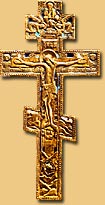 From
icons and onion domes to suprematism and the Stalin baroque, Russian
art and architecture seems to many visitors to Russia to be a rather
baffling array of exotic forms and alien sensibilities. In fact, Russian
art and architecture are not nearly so difficult to understand as
many people think, and knowing even a little bit about why they look
the way they do and what they mean brings to life the culture and
personality of the entire country. From
icons and onion domes to suprematism and the Stalin baroque, Russian
art and architecture seems to many visitors to Russia to be a rather
baffling array of exotic forms and alien sensibilities. In fact, Russian
art and architecture are not nearly so difficult to understand as
many people think, and knowing even a little bit about why they look
the way they do and what they mean brings to life the culture and
personality of the entire country.
In old Russia nearly every phase of life was colored by religion.
Every day in the calendar was dedicated to the observation of some
saint. Every individual and every trade had their patron saints. A
distinctly Russian form of representing saints and religious themes
is the icon.
|
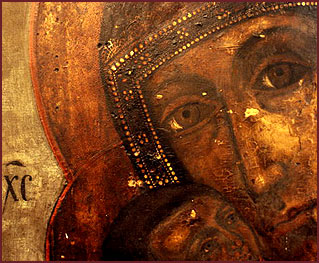 |

|
A bit of
a History
Russia's unique and vibrant culture developed, as did the
country itself, from a complicated interplay of native Slavic
cultural material and borrowings from a wide variety of foreign
cultures. In the Kievan period (c. 10th–13th centuries)
the borrowings were primarily from Eastern Orthodox Byzantine
culture. During the Muscovite period (c. 14th–17th centuries)
the Slavic and Byzantine cultural substrates were enriched and
modified by Asiatic influences carried by the Mongol hordes.
Finally, in the modern period (since the 18th century) the cultural
heritage of western Europe was added to the Russian melting
pot.
Although many traces of the Slavic culture that existed
in the territories of Kievan Rus survived beyond its Christianization
(which occurred, according to The Russian Primary Chronicle,
in AD 988), the cultural system that organized the lives of
the early Slavs is far from being understood. From the 10th
century on, however, enough material has survived to give
a reasonable portrait of Old Russian cultural life. High culture
in Kievan Rus was primarily ecclesiastical. The level of literacy
was low, and artistic composition was undertaken almost exclusively
by monks. The earliest literary works to have circulated were
translations from Greek into Old Church Slavonic.
|

|
Unlike the pictorial tradition
that westerners have become accustomed to, the Russian icon
tradition is not about the representation of physical space
or appearance.
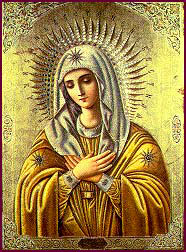 Icons
are images intended to aid contemplative prayer, and in that
sense they're more concerned with conveying meditative harmony
than with laying out a realistic scene. Icons
are images intended to aid contemplative prayer, and in that
sense they're more concerned with conveying meditative harmony
than with laying out a realistic scene.
Rather than sizing up the figure in an icon by judging
its distortion level, take a look at the way the lines that
compose the figure are arranged and balanced, the way they move
your eye around. If you get the sense that the figures are a
little haunting, that's good.
|
They weren't painted to be
charming but to inspire reflection and self-examination. If
you feel as if you have to stand and appreciate every icon you
see, you aren't going to enjoy any of them. Try instead to take
a little more time with just one or two, not examining their
every detail but simply enjoying a few moments of thought as
your eye takes its own course.
|
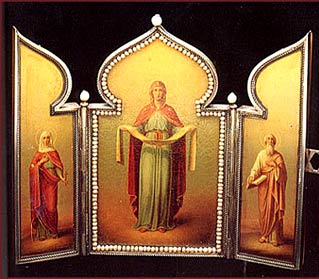 A silver-mounted triptych icon painted
with the Virgin Mary within a seed pearl border flanked by St.
Sophia (left) and St. Mathew (right).
A silver-mounted triptych icon painted
with the Virgin Mary within a seed pearl border flanked by St.
Sophia (left) and St. Mathew (right). |

|
Andrey
Rublyov Museum
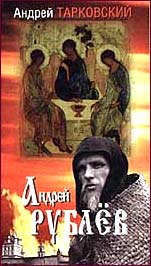 During
the 14th century in particular, icon painting in Russia took
on a much greater degree of subjectivity and personal expression.
The most notable figure in this change was Andrey Rublyov, whose
works can be viewed in both the Andret Rublyouv Museum and the
Tretyakov Gallery in Moscow, as well as the Russian Museum in
St. Petersburg. During
the 14th century in particular, icon painting in Russia took
on a much greater degree of subjectivity and personal expression.
The most notable figure in this change was Andrey Rublyov, whose
works can be viewed in both the Andret Rublyouv Museum and the
Tretyakov Gallery in Moscow, as well as the Russian Museum in
St. Petersburg.
Named after the 14th century Russian monk and legendary
icon painter, the Andrey Rublyov Museum boasts the best collection
of works by the artist and houses permanent exhibitions of
icons of the Moscow School from the 15th and 16th centuries,
sculptures from the 12th to the 17th centuries and various
religious frescoes.
|
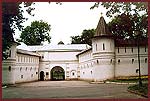 Little is known of Rublyov's life but it is thought that
he was born about 1360 and worked as an assistant to another
great icon painter, Theophanes the Greek, who came to Russia
from Constantinople. Fairly late in life, Rublyov became
a monk, first at the Trinity St. Sergius Monastery in Sergiyev
Posad and then at the Andronikov Monastery in Moscow.
Little is known of Rublyov's life but it is thought that
he was born about 1360 and worked as an assistant to another
great icon painter, Theophanes the Greek, who came to Russia
from Constantinople. Fairly late in life, Rublyov became
a monk, first at the Trinity St. Sergius Monastery in Sergiyev
Posad and then at the Andronikov Monastery in Moscow.
|
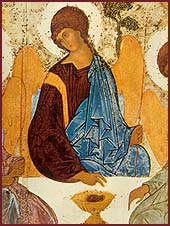 Russian
painters did not sign their works until the 17th century, so
paintings can only be assigned to Rublyov on the basis of written
evidence or of style. Extensive written evidence has linked
the medieval painter with wall paintings in Vladimir as well
as those at the Andronikov and other monasteries in Moscow. Russian
painters did not sign their works until the 17th century, so
paintings can only be assigned to Rublyov on the basis of written
evidence or of style. Extensive written evidence has linked
the medieval painter with wall paintings in Vladimir as well
as those at the Andronikov and other monasteries in Moscow.
|
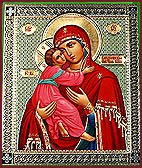 A
large number of icons have also been attributed to him, many
of which are housed in the museum or on display at the Tretyakov
Gallery. Rublyov was trained wholly in the Byzantine tradition,
in which the spiritual essence of art was regarded as more important
than naturalistic representation. A
large number of icons have also been attributed to him, many
of which are housed in the museum or on display at the Tretyakov
Gallery. Rublyov was trained wholly in the Byzantine tradition,
in which the spiritual essence of art was regarded as more important
than naturalistic representation. |
|
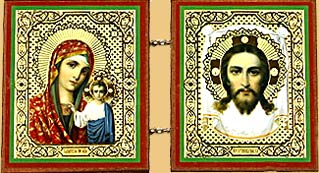
By the 14th century, this style had given way to a more
intimate, humanistic approach, and to this Rublyov was able
to add an element that was truly Russian, a complete unworldliness,
and it is this that distinguishes his work from that of his
Byzantine predecessors.
|
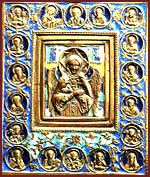 The
museum holds regular temporary exhibitions of icons and religious
works and is housed in the former Andronikov Monastery, which
was originally founded in 1360 by the then Metropolitan of Moscow,
Alexei. Excursions round the museum include a look inside the
monastery's working Spassky Cathedral, thought to be the oldest
building in Moscow and still bearing traces of murals believed
to have been painted by Rublyov himself. The
museum holds regular temporary exhibitions of icons and religious
works and is housed in the former Andronikov Monastery, which
was originally founded in 1360 by the then Metropolitan of Moscow,
Alexei. Excursions round the museum include a look inside the
monastery's working Spassky Cathedral, thought to be the oldest
building in Moscow and still bearing traces of murals believed
to have been painted by Rublyov himself.
Click
here to see more of Rublyov's icons.
|
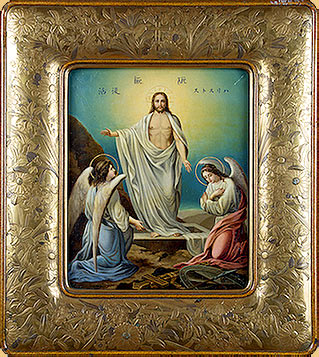
|

|
Links
The best collections of icons are to be found in the Tretyakov
Gallery (official website,
russian only) and the Russian Museum (official
website), though of course many Russian churches have preserved
or restored their traditional works.
Article about "Religion
in the Former Soviet Republics".
If you wish to purchaise Russian Icons or some other quality
Russian gifts and collectibles please visit the Russian
Store website. |
|
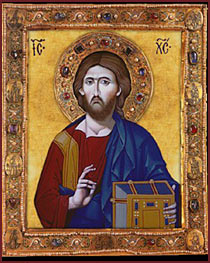 Painted
on wood, icons are known to the Russians as "obraz", but
we know them better by the term icon, which comes from the Greek word
for picture or likeness, "eikonoi". The painting of icons
is the most distinctive art form of old Russia, and Russian icons
are the most varied and beautiful of all. Painted
on wood, icons are known to the Russians as "obraz", but
we know them better by the term icon, which comes from the Greek word
for picture or likeness, "eikonoi". The painting of icons
is the most distinctive art form of old Russia, and Russian icons
are the most varied and beautiful of all.
Until recently, there was not much interest in icons. Even
in Russia, where they were common, icons were taken for granted. But
today old Russian icons are recognized as works of art by art historians
and collectors alike.
|
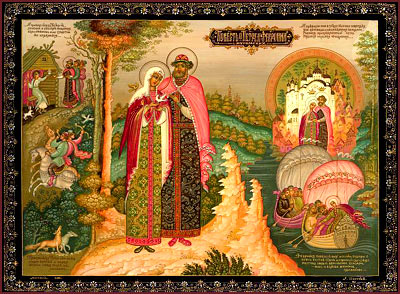
|
|
Collectors of icons should remember that the best and most
valuable icons are to be found in Soviet and European museums. A
great many, of course, have found their way to America and private
collectors. From time to time, early and rare icons are offered
for sale by prestigious auction galleries and normally bring very
high prices. Also, icons a century or two old are still found occasionally
in some better known antique shops. 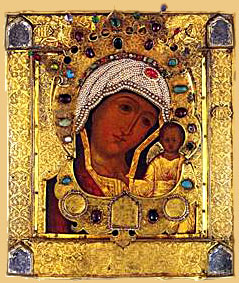 But
the majority of icons offered today are often of inferior quality.
The collector must be careful because a number of known fakes turn
up in the market now and then. When purchasing an icon it is best
to enlist help from a reputable expert. But
the majority of icons offered today are often of inferior quality.
The collector must be careful because a number of known fakes turn
up in the market now and then. When purchasing an icon it is best
to enlist help from a reputable expert.
Icon painting in Russia, as elsewhere, has followed traditional
canons. As a consequence, icons can be so like one another that
at times it is scarcely possible to distinguish between them. This
is why icons representing the same subject, although they were painted
centuries apart, can be so similar.
|
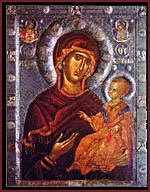 One
must keep in mind that the forms of the Russian icon remain unchanged
through the centuries. One
must keep in mind that the forms of the Russian icon remain unchanged
through the centuries.
Icons are naturally divided according to subject into two main
groups; painted icons which simply depict holy personages and icons
which depict scenes from the Scriptures or events from the lives of
the saints. Icons from the latter category serve a didactic purpose.
They have served, so to say, as an attractive and effective teaching
tool. On the other hand, icons which represent individual saints have
been the object of veneration.
|
|
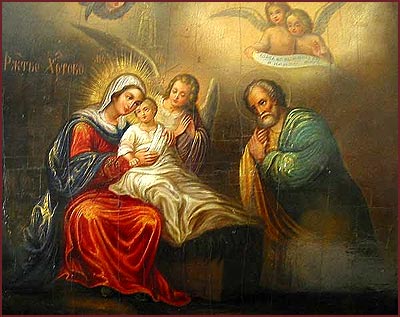
The Birth of Christ, 18 th Century
icon, Orthodox Style.
In Russian iconography, literally hundreds of themes have been represented.
Images of Christ are numerous, with the type known as 'The Saviour
Not Made by Hands' being perhaps the most popular of the Christ
representations in old Russia. There are also other representations
of Christ including depictions of the events of his life.
The enormous and varied iconography of the Virgin is even more
impressive. There are no less than three hundred types, all different.
In the Milwaukee Public Museum collection, some better known icons
of the Virgin are: 'The Virgin of Vladimir', sometimes referred to
as 'the most ancient hymn to motherhood', 'The Virgin of Tykvin',
'The Virgin of Kazan' and 'The Virgin of Shuja'. This profusion of
types if also evident in the depiction of the most popular saint of
old Russia, St. Nicholas of Myra.
|
|
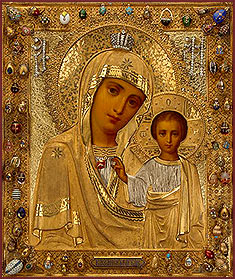 The
Festivals of the Church was another theme popular with icon painters.
Icons of this type were used in sets consisting of twelve or sixteen
scenes from the Scriptures. Furthermore, old native Russian saints
and numerous icons have preserved their images, including events
from their lives. The
Festivals of the Church was another theme popular with icon painters.
Icons of this type were used in sets consisting of twelve or sixteen
scenes from the Scriptures. Furthermore, old native Russian saints
and numerous icons have preserved their images, including events
from their lives.
The old Russian icons are not uniform in quality, all the
more so because they were created at various times and in different
icon painting centers.
The Virgin of Shuja is an excellent example of a tempera on
wood. This icon was painted on a wood panel. In order to prevent warping,
diagonal strips of wood were applied on the back. The edges of the
panel rise above the picture space from the frame. The colors were
mixed with egg yolk and diluted with kvas, a popular Russian drink
made from sour bread. The completed painting was given a coat of a
special varnish. This varnish at first enhanced the colors, but turned
dark and opaque later, producing the contrary effect. The metal frame
and halo, in the form of a crown, were added much later.
|
|
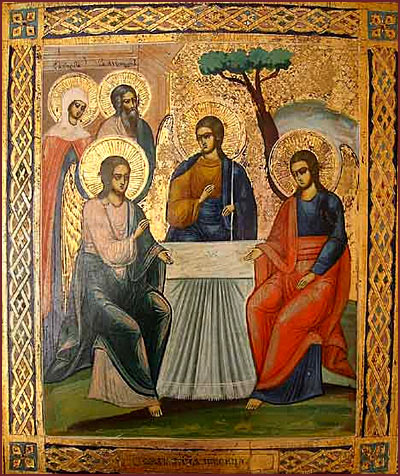
The Old Testament Trinity. 19 th Century
AD to 20 th Century AD,
Tempera on Wood, Russian Orthodox Style.
In addition to icons painted on wood, there are a number
of icons and religious objects made of metal. Most of these icons
date from the 19th century. The design is engraved on the metal
or the background cut away to leave the figures in relief and then
perhaps filled in with white or blue enamel. There is a great variety
of these icons including typical Russian crosses made in the same
manner.
|
|
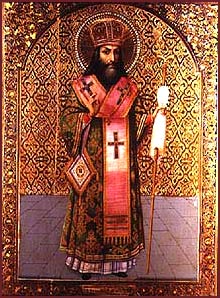 A
17th century metal icon mold might continue to be used well
into the 20th century. A very attractive brass quaditych, for example,
was cast from an old mold in Belgium in the 1950's. This is not
unusual. Many modern copies have been made in the old style and
sold to unsuspecting people in Russia and Europe. These small brass
icons sometimes consist of a single panel, of two or three panels
hinged in the form of triptych or occasionally even a larger number
of panels. They were carried by individuals for private worship. A
17th century metal icon mold might continue to be used well
into the 20th century. A very attractive brass quaditych, for example,
was cast from an old mold in Belgium in the 1950's. This is not
unusual. Many modern copies have been made in the old style and
sold to unsuspecting people in Russia and Europe. These small brass
icons sometimes consist of a single panel, of two or three panels
hinged in the form of triptych or occasionally even a larger number
of panels. They were carried by individuals for private worship.
In a further departure from classic icons, the 19th century
brought many changes. It was a period of decline, commercialism
and mechanical reproduction. A number of icon handcraft shops were
established in which cheap metal icons were produced. Icons were
printed in color on time and became very popular.
|
|
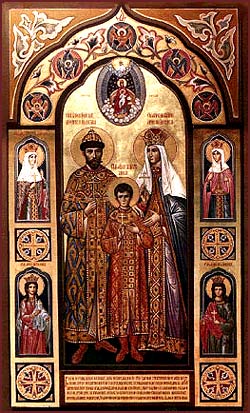 In
another development, enterprising craftsmen took advantage of technical
innovations and made metal coverings in factories. These metal coverings,
or "riza", were originally applied to icons toward the
end of the 17th century. Intended only as a partial covering of
silver, gold, or cheaper metal, the riza covers the entire painting
except faces, hands and feet. Later craftsmen, however, no longer
bother to paint the entire panel of the icon but only those parts
of the figures which were to remain visible. In
another development, enterprising craftsmen took advantage of technical
innovations and made metal coverings in factories. These metal coverings,
or "riza", were originally applied to icons toward the
end of the 17th century. Intended only as a partial covering of
silver, gold, or cheaper metal, the riza covers the entire painting
except faces, hands and feet. Later craftsmen, however, no longer
bother to paint the entire panel of the icon but only those parts
of the figures which were to remain visible.
However, it would be wrong to conclude that icons of great
charm and value were not produced in the recent past. A number of
craftsmen still continued to produce more expensive icons and preserved
the integrity of icon painting.
|
For 70 years, during Soviet
era, when religion was forbidden in Russia, icons lost its popularity.
Then came Gorbachev's
more general tolerance towards religion and the election of Patriarch
Alexy and the Metropolitan Cyril of Smolensk. The revival of religion
in Russia and the former Soviet republics brought icons back to the
Russian home. Many Russians lately have become avid collectors of
old icons. As a matter of fact, icons are in great demand the world
over, not necessarily as religious objects but for their intrinsic
artistic and historical value.

|
| |
icons | matreshka |
samovar | zhostovo
trays | lacquerwork | traditional
dress | soviet
era
|
|

 From
icons and onion domes to suprematism and the Stalin baroque, Russian
art and architecture seems to many visitors to Russia to be a rather
baffling array of exotic forms and alien sensibilities. In fact, Russian
art and architecture are not nearly so difficult to understand as
many people think, and knowing even a little bit about why they look
the way they do and what they mean brings to life the culture and
personality of the entire country.
From
icons and onion domes to suprematism and the Stalin baroque, Russian
art and architecture seems to many visitors to Russia to be a rather
baffling array of exotic forms and alien sensibilities. In fact, Russian
art and architecture are not nearly so difficult to understand as
many people think, and knowing even a little bit about why they look
the way they do and what they mean brings to life the culture and
personality of the entire country. During
the 14th century in particular, icon painting in Russia took
on a much greater degree of subjectivity and personal expression.
The most notable figure in this change was Andrey Rublyov, whose
works can be viewed in both the Andret Rublyouv Museum and the
Tretyakov Gallery in Moscow, as well as the Russian Museum in
St. Petersburg.
During
the 14th century in particular, icon painting in Russia took
on a much greater degree of subjectivity and personal expression.
The most notable figure in this change was Andrey Rublyov, whose
works can be viewed in both the Andret Rublyouv Museum and the
Tretyakov Gallery in Moscow, as well as the Russian Museum in
St. Petersburg.
 Little is known of Rublyov's life but it is thought that
he was born about 1360 and worked as an assistant to another
great icon painter, Theophanes the Greek, who came to Russia
from Constantinople. Fairly late in life, Rublyov became
a monk, first at the Trinity St. Sergius Monastery in Sergiyev
Posad and then at the Andronikov Monastery in Moscow.
Little is known of Rublyov's life but it is thought that
he was born about 1360 and worked as an assistant to another
great icon painter, Theophanes the Greek, who came to Russia
from Constantinople. Fairly late in life, Rublyov became
a monk, first at the Trinity St. Sergius Monastery in Sergiyev
Posad and then at the Andronikov Monastery in Moscow.  But
the majority of icons offered today are often of inferior quality.
The collector must be careful because a number of known fakes turn
up in the market now and then. When purchasing an icon it is best
to enlist help from a reputable expert.
But
the majority of icons offered today are often of inferior quality.
The collector must be careful because a number of known fakes turn
up in the market now and then. When purchasing an icon it is best
to enlist help from a reputable expert.